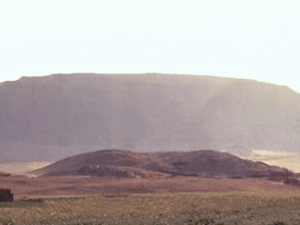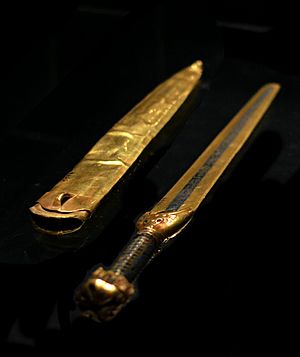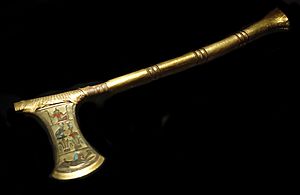Ahmose I facts for kids
Quick facts for kids Ahmose I |
|
|---|---|
| Amosis, according to Manetho, also Amasis | |
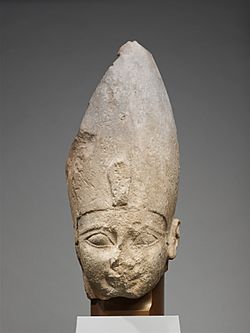
A fragmentary statue of Ahmose I, Metropolitan Museum of Art.
|
|
| Pharaoh | |
| Reign | c. 1549–1524 BC (Egyptian chronology) (disputed) 25 years and 4 months in Manetho (18th Dynasty) |
| Predecessor | Kamose (Upper Egypt), Khamudi (Lower Egypt) |
| Successor | Amenhotep I |
| Consort | Ahmose-Nefertari, God's Wife of Amun, Ahmose-Sitkamose, Ahmose-Henuttamehu, Kasmut, Thenthapi |
| Children | Ahmose-Meritamun Ahmose-Sitamun Siamun Ahmose-ankh Amenhotep I Ramose Tair possibly Mutnofret |
| Father | Seqenenre Tao |
| Mother | Ahhotep I |
| Died | c. 1525 BC |
| Burial | Mummy found in Deir el-Bahri cache, but was likely originally buried in Abydos |
| Monuments | Palace at Avaris, Temple of Amun at Karnak, Temple of Montu at Hermonthis |
Ahmose I (also known as Amosis or Aahmes) was an ancient Egyptian pharaoh. His name means "Iah (the Moon) is born." He is famous for founding the Eighteenth Dynasty of Egypt, which began the New Kingdom of Egypt. This was a time when ancient Egypt became very powerful.
Ahmose was part of the royal family from Thebes. His father was Pharaoh Seqenenre Tao, and his brother was Kamose. Thebes had been fighting against the Hyksos, who ruled Lower Egypt. When Ahmose was seven, his father was killed. His brother Kamose died when Ahmose was about ten. Ahmose then became pharaoh. He took the throne name Nebpehtire, meaning "The Lord of Strength is Re."
During his rule, Ahmose drove the Hyksos out of Egypt. He brought all of Egypt back under Theban control. He also made Egypt strong again in places like Nubia and Canaan. He improved the country's government and reopened quarries, mines, and trade routes. He started many large building projects, including the last pyramid built by an Egyptian ruler. Ahmose's reign set the stage for the New Kingdom, a golden age for Egypt. His rule is generally thought to have been in the mid-16th century BC.
Contents
Family Life
Ahmose came from the Theban Seventeenth Dynasty. His grandparents were Senakhtenre Ahmose and Tetisheri. They had many children, including Ahmose's parents, Seqenenre Tao and Ahhotep I. Following royal tradition, his parents were also brother and sister. Their children included Kamose and Ahmose I.
Ahmose I married several of his sisters, as was common for pharaohs. His main wife was Ahmose-Nefertari. They had several children, including daughters Ahmose-Meritamun and Ahmose-Sitamun. Their sons included Siamun, Ahmose-ankh, and Amenhotep I. Ahmose-ankh was supposed to be the next pharaoh, but he died before his father. So, Ahmose was succeeded by his oldest surviving son, Amenhotep I.
Historians like Manetho saw the expulsion of the Hyksos as a major event. It marked the return of Egyptian rule over the whole country. This was why they considered it the start of a new dynasty.
When Ahmose Ruled
Historians use different ways to figure out when Ahmose I ruled. One way is by looking at the Heliacal rise of Sirius, a star. This helps date his successor's reign. Because of this, Ahmose's reign has been dated to different periods, such as 1570–1546 BC or 1551–1527 BC.
Ancient records suggest Ahmose ruled for about 25 years and 4 months. An inscription from his 22nd year was found at the Tura stone quarries. His mummy suggests he died around age 35. This supports the idea of a 25-year reign if he became king at age 10.
Military Campaigns

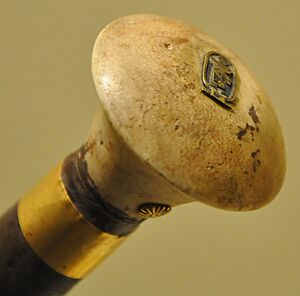
The fight between the Theban kings and the Hyksos ruler Apep began with Ahmose's father, Seqenenre Tao. This conflict lasted for almost 30 years. Ahmose's father may have died in battle against the Hyksos. His brother Kamose attacked the areas around the Hyksos capital, Avaris. Kamose ruled for only a short time before Ahmose I took the throne.
Ahmose was a child when he became king. So, his mother, Ahhotep I, ruled as his regent until he was old enough. She helped strengthen Theban power before Ahmose took full control.
Defeating the Hyksos
Ahmose began his conquest of the Hyksos-held Lower Egypt around the 11th year of the Hyksos king Khamudi's reign. The exact order of events is still debated by historians.
Much of what we know comes from notes on the back of the Rhind Mathematical Papyrus. One note says:
Regnal year 11, second month of shomu, Heliopolis was entered. First month of akhet, day 23, this southern prince broke into Tjaru.
This note likely refers to the Hyksos king Khamudi's 11th year, not Ahmose's. It calls Ahmose the "Prince of the South," which a Theban supporter would not use for their king.
The Rhind Papyrus shows Ahmose's clever strategy. He entered Heliopolis in July. Then he moved to the eastern delta to capture Tjaru (Sile) in October. Tjaru was a key border fort on the road to Canaan. By taking Tjaru, he cut off supplies and help to the Hyksos capital, Avaris. This suggests he planned to blockade Avaris.
Records from a soldier named Ahmose, son of Ebana, tell us more. Ahmose I attacked Avaris, the Hyksos capital, three times. He also had to stop a small rebellion in southern Egypt. In his fourth attack, he finally conquered Avaris. He finished his victory by capturing the Hyksos stronghold of Sharuhen near Gaza after a three-year siege. Ahmose likely conquered Avaris by his 18th or 19th year as pharaoh.
Campaigns Abroad
After defeating the Hyksos, Ahmose campaigned in Syria and Nubia. In his 22nd year, he reached Djahy in the Levant. Some think he went as far as the Euphrates River, but Thutmose I is usually credited with that. Ahmose did reach at least Kedem (near Byblos). This is known from an ostracon in his wife's tomb.
Ahmose I's campaigns in Nubia are better known. A Nubian named Aata rebelled against Ahmose but was quickly defeated. Later, an Egyptian named Tetian gathered rebels in Nubia, but he was also defeated. Ahmose brought Nubia back under Egyptian control. He set up a new center at Buhen to manage it.
Art and Buildings

When Ahmose reunited Egypt, he brought back royal support for art and building. He reportedly gave a tenth of all Egypt's production to the traditional gods. This helped restart large building projects and art. Since he defeated the Hyksos late in his reign, his building program probably lasted only about seven years. Much of it was likely finished by his son, Amenhotep I.
The materials used in Ahmose's time were much better than those from the Second Intermediate Period. With the Delta and Nubia back under Egyptian control, Egypt could get resources it didn't have before. Gold and silver came from Nubia. Lapis lazuli came from far-off Asia. Cedar wood came from Byblos. The Serabit el-Khadim turquoise mines in the Sinai were reopened. Ahmose also reopened the Tura limestone quarries. He used Asiatic cattle from Phoenicia to move the stone.
Art during Ahmose I's reign was similar to the Middle Kingdom style from Thebes. This showed a desire to bring back styles from before the Hyksos era. Only a few statues of Ahmose I have been found. These include a small shabti (a funeral figurine) and two life-size statues. One is at the Metropolitan Museum of Art in New York, and the other is in the Khartoum Museum.
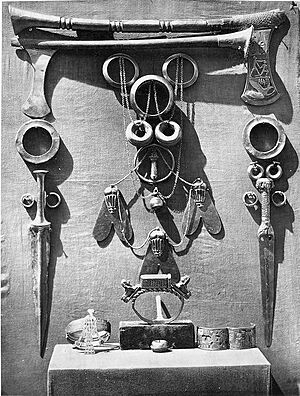
Glassmaking is thought to have started during Ahmose's reign. The earliest glass pieces seem to have been mistakes from making Egyptian faience. But intentional glass crafting began in the early 18th dynasty. One early glass bead has the names of both Ahmose and Amenhotep I. This suggests that glassmaking was developed by one of Ahmose's subjects.
Ahmose restarted big construction projects like those before the Second Intermediate Period. In the south, he built temples mostly from brick, including one in Buhen, Nubia. In Upper Egypt, he added to the Amun temple at Karnak and the Montu temple at Armant. He also started building a temple to Ptah and a southern part of the Amun temple using white limestone. He built a special monument (a cenotaph) for his grandmother, Tetisheri, at Abydos.
Archaeologists found that Ahmose built a palace at Avaris, where the Hyksos capital used to be. This palace had frescoes (wall paintings) in a Minoan style. This suggests trade and artistic connections with the Minoan civilization.
Under Ahmose, Thebes became the capital of all Egypt again. It also became the center for a new professional civil service. This meant more demand for scribes and educated people. Thebes was a good choice for a capital because it was in the middle of the country. This made it easy to respond to threats from the Hyksos in the north or Nubians in the south.
A major change was religious. Thebes became the main religious center. Its local god, Amun, was credited with Ahmose's victories over the Hyksos. The Karnak temple complex grew in importance. The older cult of Ra in Heliopolis became less important.
Several stone tablets (stelae) found at Karnak describe Ahmose's work. One, called the "Tempest Stele," says he rebuilt pyramids in Thebes that were damaged by a great storm. Some scholars think this storm might have been caused by the Thera eruption in the Aegean Sea.
Ahmose's Pyramid
The remains of Ahmose's pyramid at Abydos were found in 1899. Most of its outer stones were taken for other buildings over time. However, some intact stones were found, showing it had a steep slope. Near the pyramid, two temples built by Ahmose's queen, Ahmose-Nefertary, were found.
This pyramid complex might have been connected to other monuments nearby. These include a large pyramid for his grandmother Tetisheri. It also includes an underground complex that might have been a symbolic underworld or a royal tomb. There was also a terraced temple built against cliffs. These elements show styles from both the Old and Middle Kingdom pyramid complexes.
There is some debate about whether this pyramid was Ahmose's actual burial place or just a cenotaph (a monument to someone buried elsewhere). No burial chamber has been found inside. Some historians believe he was buried at Abydos because of the many cult structures and a cemetery for his priests found there. Others think the pyramid was a cenotaph, and he was buried in Thebes.
This pyramid was the last one built as part of a royal burial complex in Egypt. Later pharaohs of the New Kingdom stopped building pyramids. This was partly because Thebes didn't have much open space like Giza. Also, pyramids were linked to the sun god Ra, but Amun became more important. Amun's name meant "the hidden one," which allowed pharaohs to hide their tombs. This helped protect them from tomb robbers. All later New Kingdom pharaohs were buried in hidden rock-cut tombs in the Valley of the Kings.
Ahmose's Mummy
Ahmose I's mummy was found in 1881 in the Deir el-Bahri Cache. This was a secret hiding place for many royal mummies. He was found with other pharaohs like Amenhotep I, Thutmose I, and Ramesses II.
His mummy was unwrapped in 1886. It was in a coffin with his name on it. His name was also written on his bandages. The coffin was from the 18th dynasty but wasn't very fancy. It seems to have been moved from its original burial place. Around his neck was a garland of flowers. The body showed signs of being robbed in ancient times; his head was broken off, and his nose was smashed.
The mummy was about 1.63 meters (64 inches) tall. It had a small face with slightly prominent front teeth. This might have been a family trait, seen in other mummies from his family.
Early studies thought he was in his 50s when he died. But later exams showed he was likely in his mid-30s. In 1980, some scholars questioned if this mummy was truly Ahmose I. They noted that his skull shape was different from his father's and sister's mummies. Also, this mummy's arms were not crossed over the chest, which was common for male pharaohs of that time. Because of these reasons, the identity of this mummy as Ahmose I is still debated.
The mummy is now in the Luxor Museum. It is part of an exhibit called "The Golden Age of the Egyptian Military."
Who Ruled Next
Ahmose I was followed by his son, Amenhotep I. Some scholars think Ahmose and Amenhotep might have ruled together for a few years. This is called a coregency. If they did, Amenhotep could not have become king before Ahmose's 18th year, when Ahmose-ankh (the first heir) likely died.
There is some evidence for a coregency, but it's not definite.
- Some small objects have both their royal names together. This suggests they were both alive and ruling at the same time. However, Amenhotep I might have just wanted to honor his father.
- Amenhotep I seemed to be preparing for a sed festival, a special celebration usually held after 30 years of rule. But Amenhotep I only ruled for about 21 years. If he had a coregency, he might have planned the festival based on when he first became king, not when he ruled alone.
- Ahmose's wife, Ahmose Nefertari, was called "King's Great Wife" and "King's Mother" in inscriptions from Ahmose's 22nd year. For her to be a "King's Mother," Amenhotep would have to be king already. However, this title could also be honorary.
Because of this uncertainty, a coregency cannot be fully proven or disproven. If there was one, it wouldn't change the timeline of the period. This is because the successor would start counting their reign from when they ruled alone. However, some believe a coregency would have been smart. It would prevent fights for the throne after the pharaoh's death, especially since Ahmose faced rebellions.
Images for kids
-
Copper axe blade inscribed with the titulary of pharaoh Ahmose I, Ashmolean Museum.
See also
 In Spanish: Amosis I para niños
In Spanish: Amosis I para niños


